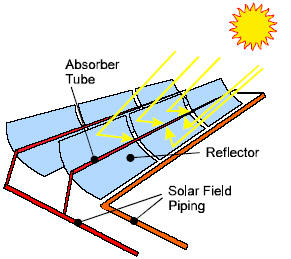
Tower CSP In the foreground and Trough CSP behind it in this photo of the NOOR I, II, II CSP project at Ouarzazate, Morocco, completed in 2018. This project has about half the capacity of a typical 1 GW nuclear power plant.
All concentrating solar power (CSP) technologies use a mirror configuration to concentrate the sun’s light energy onto a receiver and convert it into heat. The heat can then be used to create steam to drive a turbine to produce electrical power or used as industrial process heat.
Concentrating solar power plants built since 2018 integrate thermal energy storage systems to generate electricity during cloudy periods or hours after sunset or before sunrise. This ability to store solar energy makes concentrating solar power a flexible and dispatchable source of renewable electricity, like other thermal power plants, but without fossil fuel, as CSP uses the heat of highly concentrated sunlight.
CSP systems can also be hybridized with combined cycle power plants, resulting in hybrid power plants that provide high-value, dispatchable power. They can also be integrated into existing thermal-fired power plants that use a power block like CSP, such as geothermal, natural gas, or biofuel plants. CSP plants can also use fossil fuel to supplement the solar output during periods of low solar radiation. In that case, a natural gas-fired heat or a gas steam boiler/reheater is used.
There are four types of CSP technologies, with the earliest in use being parabolic trough CSP and the fastest growing since 2017 being central tower CSP due to its higher temperature capabilities. Fresnel and Dish are alternative types of CSP.
There have been various design variations or different configurations for each type of CSP. For example, several early projects tried water as a heat transfer fluid (Khi Solar I, Ivanpah) or did not include thermal energy storage (Ivanpah), making them less effective at generating solar during intermittent cloudiness.
The importance of thermal energy storage
The key to the dispatchability of CSP is that it can store the heat of sunlight thermally. Recognition of the importance of this capacity for thermal energy storage inherent in CSP can be seen in a new regulation In China, making the inclusion of thermal energy storage in CSP a requirement and its order on the grid prioritized.
The last large CSP project to be built without thermal energy storage was the Ivanpah project in California, completed in 2013. Other than one of the two Israeli projects by the same developer, all CSP built since that time has included thermal energy storage in molten salts, which have been proven effective. Research continues into Gen3 heat transfer and storage in other materials which can hold even higher temperatures. This research is resulting in the ability of CST to supply high-temperature direct heat for industrial processes and for solar thermochemistry in solar reactors to make solar fuels.
Parabolic Trough Systems:

In a parabolic trough CSP system, the sun’s energy is concentrated by parabolically curved, trough-shaped reflectors onto a receiver pipe running along about a meter above the curved surface of the mirrors. The temperature of the heat transfer fluid flowing through the tube, usually thermal oil, is increased from 293ºC to 393ºC, and the heat energy is then used to generate electricity in a conventional steam generator.
A collector field comprises multiple parabolic trough-shaped mirrors in parallel rows aligned to enable single-axis trough-shaped mirrors to track the sun from east to west during the day to ensure that the sun is continuously focused on the receiver pipes. As of 2018, 90% of the CSP in commercial operation is trough. Trough deployment database.
Power Tower Systems:

Power tower or central receiver systems utilize sun-tracking mirrors called heliostats to focus sunlight onto a receiver at the top of a tower. A heat transfer fluid heated in the receiver up to around 600ºC is used to generate steam, which, in turn, is used in a conventional turbine generator to produce electricity.
See the SolarPACES-NREL database of global CSP Tower deployment
Linear Fresnel Systems:

Similar to the long arrays of a parabolic trough CSP system, a Linear concentrating collector field consists of many collectors in parallel rows. These are typically aligned in a north-south orientation to maximize annual and summer energy collection. The mirrors are laid flat on the ground and reflect the sunlight to the pipe above. Like trough and tower CSP, Fresnel CSP can also incorporate storage in a power block or generate steam for direct use. Fresnel deployment database.
Parabolic Dish Systems:

A Parabolic dish system consists of a parabolic-shaped point focus concentrator in the form of a dish that reflects solar radiation onto a receiver mounted at the focal point. These concentrators are mounted on a structure with a two-axis tracking system to follow the sun. The collected heat is typically utilized directly by a heat engine mounted on the receiver moving with the dish structure. Stirling and Brayton cycle engines are currently favored for power conversion. Dish deployment database.
